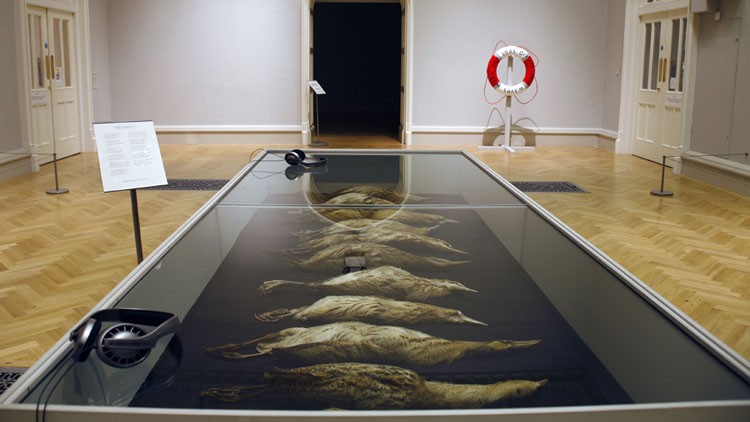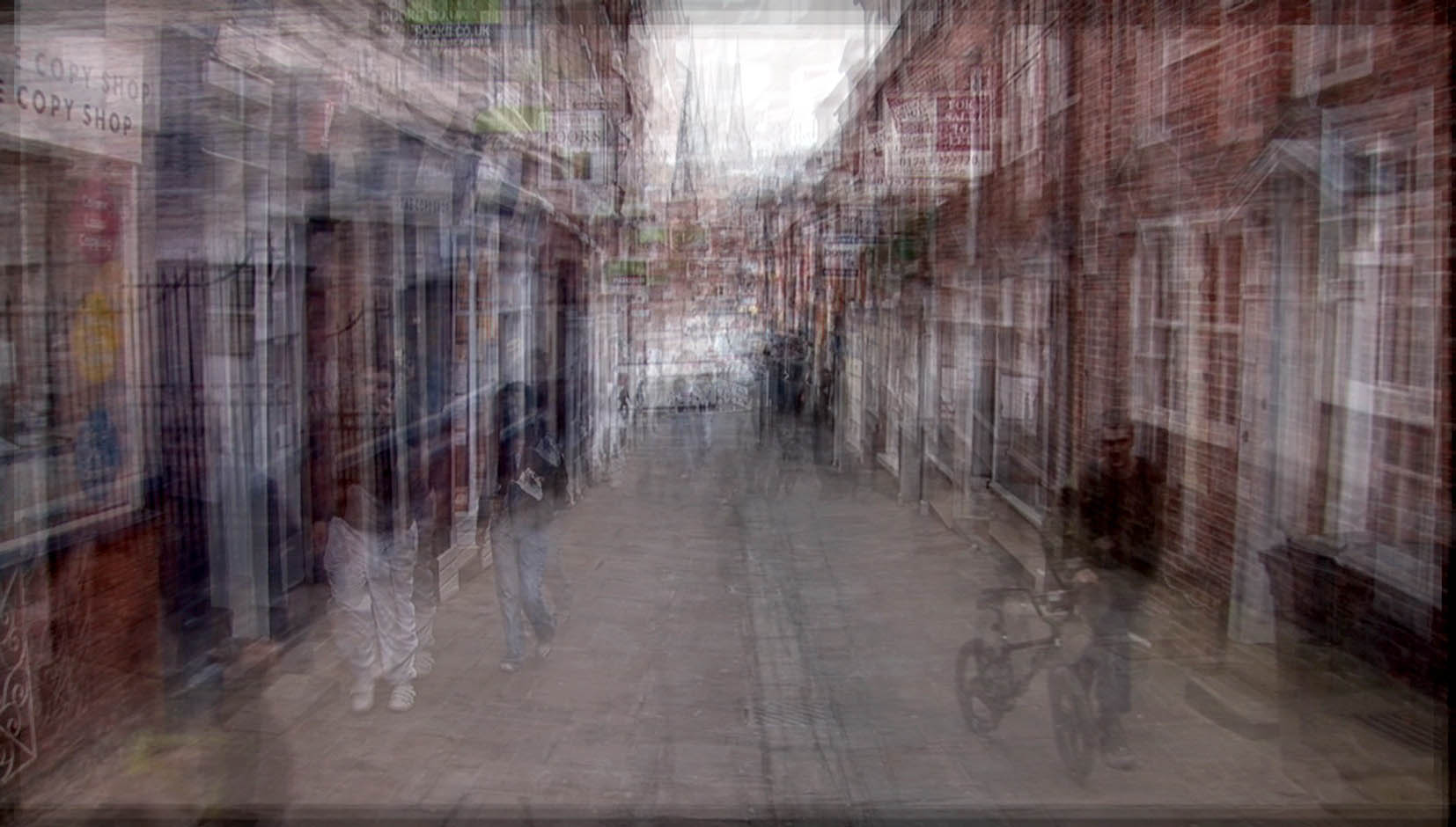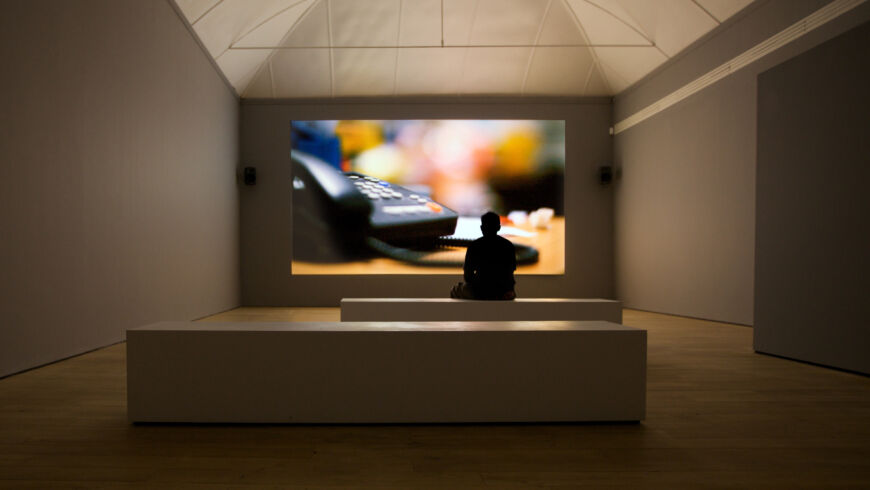In Unison
Steven Bode
Steven Bode tunes into the lingering resonances of Marcus Coates’ work, and how its ecological message reverberates in the present.
Projects
'Follow the Voice' by Marcus Coates is available now on FVU Watch.
Marcus Coates has always had something of the Pied Piper about him. He might not actually manage to charm the birds from the trees, but, as key works such as Dawn Chorus (2007) or A Guide to the British Non-Passarines (2002) attest, he has become highly adept at mimicking their different calls. Noted for his nightingale song, Coates can usually be relied upon to startle with his discordant, sometimes feral appearance – a kind of rustic, hotchpotch harlequin garb that attracts curiosity and makes people want to follow him wherever he goes, which is often into mysterious, borderline territory. In Journey to the Lower World (2003), and in other later projects, he dons the rabbit-footed (and faintly hare-brained) get-up of a shaman to better commune with an invisible pantheon of animal spirits. Whether Coates actually talks with the animals is almost beside the point. There is such sincerity in his efforts to do so that his audience (and we, the viewers) are already under his spell.
On the face of it, Coates’ 10-minute video Follow the Voice (2009) seems less attuned to the siren call of wild nature than the background hubbub of mundane human activity. The automated beep of a supermarket checkout counter or the robotic alert of an approaching lift are picked out as concrète examples from a subliminal soundtrack of everyday life. Slowed down, sped up, or otherwise pitch-shifted, these simple, repeating signature patterns find an uncanny echo in the cries and calls of birds or other creatures, which are subsequently highlighted alongside each clip. Like a harmony part dovetailing with the melody line, these companion sounds evoke a deeper, underlying kinship, reminding us of an inherent similarity between some of the most basic guttural forms of human and non-human communication, while foregrounding the unspoken, often unconscious behavioural origins of diverse cultural or technological phenomena.
Follow the Voice was inspired by Charles Darwin’s seminal treatise ‘The Expression of the Emotions in Man and Animals’, and was commissioned to mark the bicentenary of Darwin’s birth within a programme of cultural events in his home city of Shrewsbury. For much of the latter half of the 19th century, Darwin was a voice in the wilderness for proposing homo sapiens’ close proximity to apes, and their shared descent from a common ancestor, and for ascribing the origin of species not to divine creation but to a gradual, iterative process of selective evolution spanning millions of years. Darwin’s theories are now, of course, established scientific facts. But just as important a part of his legacy is his acute and highly sophisticated appreciation of the extent to which the glorious abundance of life on earth is interconnected and interdependent – an early ecological insight that strikes an increasingly resonant chord. And especially with a recent groundswell of artists and writers, working in the shadow of the climate crisis and a concomitant loss of biodiversity, for whom ethical notions of interspecies kinship and ecological entanglement are a rallying cry and clarion call.
Looking back at Follow the Voice, alongside some of the artist’s earlier works, it is hard not to feel that Coates was ahead of the curve – or, at least, keenly aware of which way the wind was blowing. His work is prescient in other ways too. Two years earlier, for another Film and Video Umbrella project, Coates had made two new pieces that premiered at galleries in Norwich and Lincoln. The first of these was a work called Britain’s Bitterns (2007), which consisted of a large display case housing eleven unstuffed carcasses of this elusive, rare bird; actually specimens from Norwich Castle Museum’s Natural History collection. The choice of eleven was significant, in that it was the sum total of male bitterns recorded across the whole of the UK only a few years previously; the bird’s numbers having plummeted since the Second World War, mostly as a result of human impact and habitat loss. Circling around the sepulchral vitrine, like a lament at a wake, was a recording of a folk song, composed by Coates and performed in a Norfolk dialect, that imagined the shrinking horizons of their world, as seen through the bitterns’ eyes.

Marcus Coates, Britain’s Bitterns c.1997 (2007), installation view at Norwich Castle Gallery.
The air of melancholy deepened a few months later, when Coates put together a further musical work for the second staging of the exhibition in Lincoln. Cadences (2007) is a 15-minute audio collage that comprises a series of ‘last bars’ of pieces of orchestral music (by composers such as Elgar, Vaughan Williams, Delius, Holst and Gurney) that could be loosely bracketed together as part of an English pastoral tradition. The piece’s short-lived sound-swells come and go, one after another, like waves upon the shore, while the mental pictures they create flicker and fade out like the last glints of sunlight over a landscape. Although most of the original scores hymn the green and pleasant features of a mythic Arcadian England, Cadences’ stop-start soundscape doesn’t suggest a stirring panorama but rather a succession of epitaphs for it. The mood is nostalgic, and valedictory: like a tolling bell mourning a moment that is passing, that has maybe already gone. A lost England of hope and glory may not be a cause for regret. But a natural world in terminal danger is palpably something to grieve.
There is an augury of this in Follow the Voice. As we watch its episodes unfold, seeing human beings shop, play, travel, socialise, strangely oblivious, fiddling while wildfires burn, the piece’s background chorus of non-human voices takes on a deeper poignancy. Many animal calls are often alarm calls or distress calls, but they are also contact sounds, sent out to elicit a response; a little memo saying: ‘I am here’. Is anyone listening? Coates certainly is. Follow the Voice, like all his work, exhorts us to recognise our affinities with, and connection to, the multiple life forms with whom we share the planet. In the midst of the so-called Anthropocene, surrounded by evidence of the damage that humans are doing to the environment, it has a central, compelling message: that the fates of all creatures great and small, of humans and non-humans alike, are inextricably bound up together; and, because of this, best confronted together, in unison.
—
Steven Bode is Director of Film and Video Umbrella.


